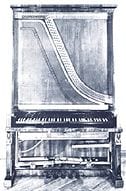Piano with Automatic Accompaniment System in Beethoven's Day

Modern pianos usually have three pedals. Among them is one called the damper pedal that functions to sustain the sound, and another called the una corda pedal that softens the sound.
However, in Beethoven's day, when pianos were a symbol of "high technology," many pianos were built that had four or more pedals. In Vienna, pianos built by a man named Georg Haschka were known for their multiple pedals, among which was an instrument with eight pedals. The purpose of the pedals of this era was to change the tone and timbre of the notes like the stops of an organ. A classic example of this is the so-called "Turkish" or "Janissary" (Janitscharen) pedal that, when pressed with the foot, played cymbals, bells, and drums in synchrony with the keyboard in imitation of the sound of a Turkish military marching band. This could be called a 19th-century version of the piano with automatic accompaniment system which we can experience on Diskvier pianos today.
(Reference: "Ongaku Kikai Gekijo" ("Music Machine Theatre"), by Hiroshi Watanabe, 1997; published by Shinsho-kan)
คู่มือเครื่องดนตรี: รายละเอียดเกี่ยวกับเปียโน
ต้นกำเนิด
โครงสร้าง
วิธีการเล่น
เครื่องดนตรีนี้ถูกผลิตขึ้นอย่างไร
การเลือกเครื่องดนตรี
การดูแลและบำรุงรักษา
ถามตอบ
- คีย์สีขาวและคีย์สีดำกลับตำแหน่งกันบนเปียโนใน Mozart's Day
- เปียโนของ Mozart มีแป้นเหยียบหรือไม่?
- เปียโนกับระบบการจับคู่อัตโนมัติในวันของเบโธเฟน
- เปียโนที่เป็นที่รักที่สุดของปราชญ์ทางดนตรีผู้ยิ่งใหญ่ Sviatoslav Richter
- วัสดุที่ดีที่สุดสำหรับเฟรมเปียโนก็เหมาะที่สุดสำหรับสำหรับเครื่องยนต์รถจักรยานยนต์ด้วย
- ซาวด์บอร์ดเปียโนเป็นบอร์ดที่หยุดการสั่นสะเทือนได้
- ทำไมเปียโนไม่มีมากกว่า 88 คีย์?
- ทำไมคีย์บอร์ดของแกรนด์เปียโนถึงรู้สึกหนักกว่าอัพไรท์คีย์บอร์ด?
